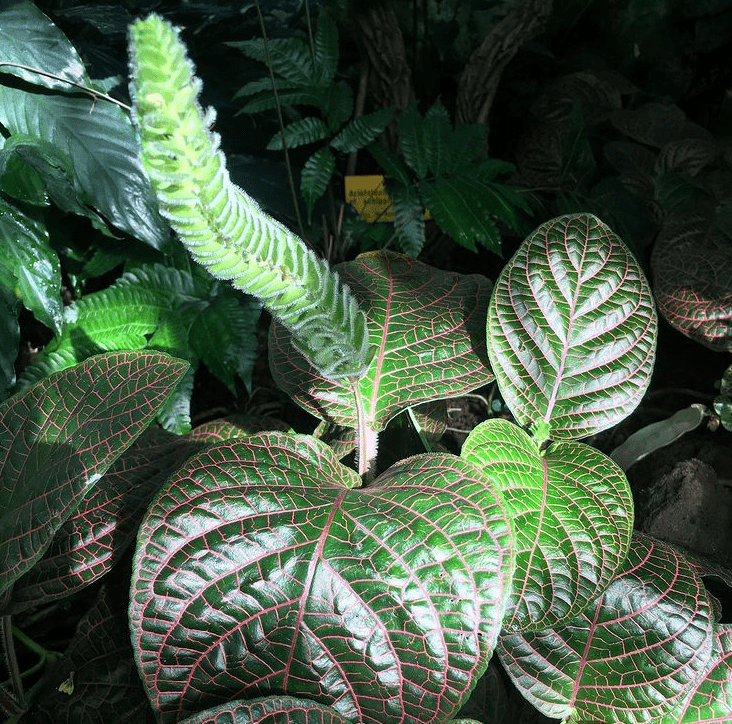Fittonia plant: Popular species and care tips

Plant description
Fittonia is a genus of perennial plants belonging to the Acanthaceae family. The plants of this genus are native to the rainforests of South America (Colombia and Peru). They are most often called by their Latin name “Fittonia”, “Nerve plants” or “Mosaic plants”. These pretty little indoor plants are perfect for tabletops, hanging baskets, and terrariums. The patterned foliage of these trailing, drooping houseplants is very striking with oval, deep-green leaves arranged in pairs on a short petiole. Furthermore, the most attractive part of this beauty is the silvery-white veins that are also red, pink, white, or green in some varieties. The blooms are insignificant with reddish to yellowish-white spikes and tend to blend in with the remainder of the foliage. Also, these plants rarely flower when grown indoors. Fittonia care is fairly easy, just give them what they need, they will certainly thrive and make you happy at the same time.
Popular Fittonia species
Fittonia albivenis

Fittonia albivenis, also known as Pink Angel, is a creeping perennial plant that comes from tropical rainforests in South America. This beautiful species is mainly used as a ground cover, as a desktop plant or also in terrarium-like setups such as vivariums and paludariums. Pink angel is recognized by its remarkable dark green foliage which presents very contrasting colored pink veins, but you can also readily find varieties with silvery-white and green veins. This Fittonia species can be quite sensitive to watering and yellowing of leaves indicates overwatering. As a houseplant, it is spreading and works well in a pot or hanging basket and stays fairly small.
Fittonia gigantea

Fittonia gigantea is an evergreen perennial mat-forming, creeping plant native to Ecuador (Pastaza). This species can reach 60 cm height and has purple stems, oval, pointed, dark-green leaves and dark red veins. Fittonia gigantea produces spikes of white labiate flowers and capsules of loculicidal dehiscence. This cute plant can be grown under glass as houseplants but also as a groundcover in mild climates.
Fittonia verschaffeltii

Fittonia verschaffeltii, named also red nerve plant, is a perennial tropical plant native to Peru. This compact plant has unique patterned foliage with dark green leaves and red to pink veins. It can sporadically produce little yellow blooms if it finds the right growing conditions. This species contains many cultivars, including ‘Argyroneura’ (silver-white veins), ‘Pearcei’ (reddish veins) and ‘Mosaïc Kings Cross’ (White plant with small white leaves dotted with green). They are all well suited to terrarium culture.
How to propagate Fittonia?
The propagation of fittonia is very easy. It can be easily grown by layering because it produces a stem that is in contact with the earth will naturally take root after a few days to a few weeks. It can be grown also by stem cuttings during spring or summer. The division is also possible after a few years when the plant is mature and healthy.
Nerve plant care

Watering
Fittonias are very sensitive to watering, they don’t like to have their soil dry out, but they don’t like it to be wet. So, water regularly but moderately. Count 2 to 3 waterings per week during the growth period. Preferably use soft water at room temperature.
Humidity and Temperature
As the most tropical plants, Fittonias love high humidity, so keep the air moist so the leaves look their best. Moreover, Nerve plants thrive in average room temperatures between 18-26 °C. Then, keep them away from drafty windows when it’s cold and from airflow from heaters.
Light
Fittonia requires similar conditions of tropical forests. That’s mean bright but indirect light. Lower light can cause it to lose some of its vibrant color and growth will slow. Too much light can burn the leaves.
Soil
Fittonias love humid environments and don’t do very well when they’re in dry soil. So keep your Fittonia’s soil consistently moist and mist often. They grow well in well-drained, standard potting soil with a peat-moss base.
Fertilizer
Fertilize just during the growing season, from March to September. Then add a green plant fertilizer to its irrigation water once every two weeks. Be sure to follow the directions on the fertilizer package.
Pests and diseases
Usually, there are no particular diseases or parasites. Just watch out for green aphids which leave sticky marks on the leaves and deform them.
The most common problems that must be avoided are especially overwatering (leaves which turn yellow), lack of water (shrivelled leaves) or cold (leaves which fall).
Did you find this helpful? Share it with your friends!